#universe: 1872
Text
if stevetony not canon then why red and blue blonde and brunette life and death moon and sun short and tall dog and cat
#stevetony#616#mcu#steve rogers#tony stark#stony#1872#earth's mightiest heroes#avengers assemble#literally them in every universe they r multiverse soulmates#they live rent free in my brain i need to send them both of therapy tho#are u rly soulmates if u dont try to kill each other and also end the world together in battle
332 notes
·
View notes
Note
Does Steve propose to Tony or does Tony propose to Steve?
steve proposes to tony in MCU and Ults
tony proposes to steve in 616
neither of them propose to each other in 1872 or dark ages, but they are for all intents and purposes devoted to each other for life (though it is not necessarily exclusive devotion in dark ages 👀)
in noir tony declares his enduring romantic love to steve under emotional and physical duress as they face a certain death situation to which steve responds by pulling out a beautiful and precious age-old ring that he kept from one of their first adventures together and that he painstakingly restored so that one day he could give it to tony. they kiss (for the first time ever) and make a great escape
and in emh one of them casually asks the other if they want to get married while they're talking one night and the other says yeah sure and then they go get their licenses that weekend. jan is livid when she hears about it after the fact until they give her full rights to planning the ceremony
#stevetony#my headcanons#anon#signed sealed delivered#cute!!! they're lovely in every universe :'))))))#EMH#noir#616#1872#1872 my beloved#dark ages#1610#mcu
21 notes
·
View notes
Text
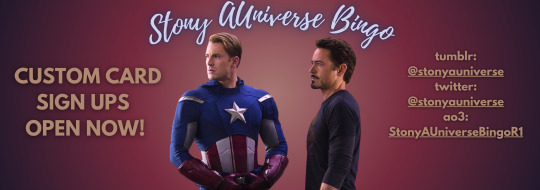
Rules | Tumblr | AO3 | Twitter | Discord
CUSTOM CARD SIGN UPS ARE OPEN NOW!
Sign up for your custom card now! Sign ups will be open from now until June 20th. You will receive your card on June 30th when Round 1 begins!
Please read our rules, join our Discord, and don't hesitate to reach out if you have any questions!
You must be 18+ to participate.
#stony#stevetony#tonysteve#steve x tony#tony x steve#tony stark#steve rogers#iron man#captain america#marvel#marvel cinematic universe#mcu#marvel comics#marvel 616#marvel ultimates#marvel 1872#avengers#avengers assemble#announcement#stonyauniverse#stonyauniversebingo#marvel event
41 notes
·
View notes
Text

ROUND ONE OF THE WINTERIRON BINGO IS STARTING MARCH 10TH!
We are happy to announce the 2023 WinterIron Bingo Round 1. We know there are no active WinterIron Bingos at the moment, and we felt the need to ensure Tony & Bucky got some Bingo love!
We've worked hard to ensure that this Bingo is a unique, tailored experience for you all. Custom cards are available, as well as nine different badges, six of which are Tony/Bucky themed!
Rules ⎊ Fill Submission, Square Swaps, Adoptables, & Badge Guidelines ★ Sign Up (Starting March 10th) ⎊ AO3 Collection ★ Twitter ⎊ Discord
Please join us on Discord if you're interested in participating in the WinterIron Bingo! The server is up and ready to go, and we'd love to get to know you and talk all things WinterIron leading up to the Bingo!
Our Tumblr should have all the information you need, but let us know if you have further questions after reading the links above!
Please follow us here on Tumblr and/or on Twitter to ensure you see any and all announcements! Additionally, as stated in the rules, we will be happy to retweet and reblog your fills, respectively.
Let's give WinterIron the love it deserves!
#winteriron#bingowinteriron#winteriron bingo#tony stark#bucky barnes#bingo#marvel bingo#marvel event#marvel#marvel comics#marvel cinematic universe#mcu#marvel 616#marvel ultimates#marvel 1872#avengers assemble#marvel fanfiction#marvel fanart#marvel moodboard#marvel playlist#avengers#iron man#winter soldier#starkbucks
57 notes
·
View notes
Text

SIGN UPS ARE OPEN NOW!
AO3 SIGN UP HERE | PINCH HITTER SIGN UPS HERE
Sign ups for the exchange will stay open until 12pm noon EST on March 10th. You have plenty of time to sign up and share this post with all your fandom friends!
All Marvel universes are welcome! This is not in any way, shape, or form an MCU-only event.
All ships are accepted (given that they follow our guidelines of not being underage or an incestuous relationship.)
A reminder that you are signing up to both make and receive a gift, either fanfiction or fanart. First, you'll be asked what you want made for you (your request), then you'll fill out what you're willing to make (your offer).
If you have any questions, don't hesitate to reach out.
Before signing up, you must have read and understood our rules and FAQ. Don't forget to follow us on Twitter!
RULES | FAQ | SCHEDULE | HOW TO SIGN UP | TWITTER
Time to begin the party planning!
#tony stark#iron man#marvel#marvel event#marvel fanfiction#marvel fanart#marvel cinematic universe#mcu#marvel comics#marvel 1872#marvel 616#marvel noir#avengers#avengers assemble#stony#winteriron#ironshield#ironstrange#ironfrost#iron widow
44 notes
·
View notes
Text
MCU Steve: I defeated my enemies and brought justice to them and the people I defended.
1872 Steve: I shot my enemies dead when they attacked me and strung their corpses up in front of my mayor's residence as a warning.
#steve rogers#everything special#1872#1872 Marvel#mcu#me my mine#i love all steves across all universes
4 notes
·
View notes
Photo
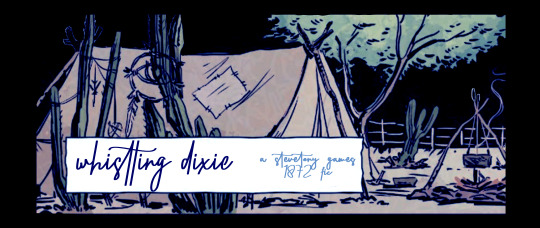
whistling dixie by starvels
1400~ Words, M. 1872 Comics. Steve/Tony. Mutual Pining. Canon Div.
“Well,” Steve says, voice rough. He takes in another of those sharp breaths and when he exhales, Tony feels it like the forge, billowing heat out into his chest. “Mayhap you best keep that dry, Stark.”
He sounds like molten metal, like the best slather of butter over a butt of bread, sounds fair peckish for something more than trail gruel and he’s looking at Tony like Tony’s the place he’s gonna get it.
Yes, Tony thinks. It is. Take it. Take me.
for team fuck in the @stevetonygames 2022. week 2: incorrect quotes challenge + gambling bingo square.
#stevetony games#stevetony#my fic#1872#:)))))))))))))))))))))))))) my faveo universe lately hehe#v fun to write in#just a wee little header for this so i can feel comfy posting it here
17 notes
·
View notes
Text
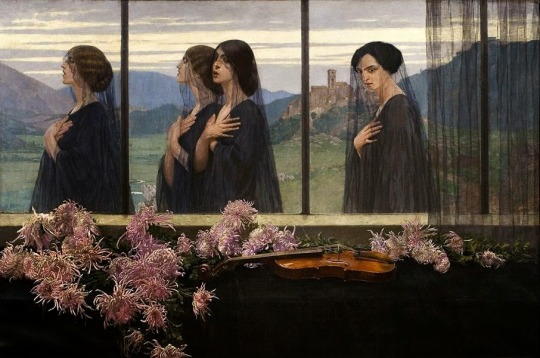
Edward Okuń (1872-1945)
"The Four Strings of a Violin" (1914)
Located in the Arizona State University Art Museum, Tempe, Arizona, United States
#paintings#art#artwork#painting#funeral#edward okuń#edward okun#fine art#museum#art gallery#polish artist#musical instruments#instrument#pink flowers#clothing#clothes#black dress#dresses#side profile#female portrait#portrait of a woman#veil#1910s#early 1900s#early 20th century#a queue work of art#1k#2k
2K notes
·
View notes
Text
Non-offensive Historical terms for Black people in historical fiction
@pleasespellchimerical asked:
So writing historical fiction, with a white POV character. I'm not sure how to address race in the narration. I do have a Black main character, and I feel like it'd feel out of place to have the narrator refer to her as 'Black', that being a more modern term. Not sure how to do this without dipping into common historical terms that are considered racist today. Thoughts on how to handle this delicately, not pull readers out of the narrative? (fwiw, the POV character has a lot of respect for the Black character. The narration should show this)
There are non-offensive terms you can use, even in historical fiction. We can absolutely refer to Black people without slurs, and if slurs is all one can come up with, it’s time to go back to the drawing board. I cannot say which terms are best for your piece without knowing the time period, but hopefully the list below helps.
Historical terms to use for Black people (non-offensive)
African American documented as early as 1782 (documented in an ad in the Pennsylvania Journal). Note the identity isn’t accurate for non-American Black people.
African could refer to African people or “from 1722 as ‘of or pertaining to black Americans.’”
The place of origin could also be used. For example, “a Nigerian woman”
Africo-American documented as early as 1788.
People of Color documented as early as 1796 (with specific contexts, usually mixed people)
Afro American documented as early as 1817, 1831 (depending on source)
Black American documented as early as 1831
Black was used in Old English to refer to dark-skinned people. Black was not capitalized until recent years, so “She was a young black woman.” would make sense to say, though “She was a young Black woman.” is the better standard today, although not universally adopted. I personally prefer it capitalized.
Moor was used as early as the late 1400s for North African people, but had a somewhat flexible use where anyone visibly Black / Of African descent or the Afro Diaspora might be referred to or assumed as a Moor. Note, it has other meanings too, such as referring to Muslim people, but that doesn’t mean the person using it is going by the dictionary definition. Not really the way to go today, but okay in a historical setting (in my opinion).
Biracial (1860s), mixed race (1872), multiracial (1903) and multicultural (1940s) are also terms to refer to people of two or more races.
Occupation + description. Throughout history, many people have been referred to as their occupation. For example, the Carpenter, The Baker, the Blacksmith. Here’s an example of how you might go about using occupation and traits to identify a Black character in history. Here’s an example I came up with on the fly.
“You should go by Jerry’s. He’s the best blacksmith this town’s ever seen. Ya know, the real tall, dark-skinned, curly haired fellow. Family’s come here from Liberia.”
Offensive and less-sensitive terms for Black people
Blacks was used in plural more, but this is generally offensive today (Even writing it gives me **Thee ick*)
Colored was mostly used post-civil war until the mid 20th century, when it became unacceptable. This is not to be conflated with the South African Coloured ethnic group.
Negro/Negroes were also used as early as the 1550s. Capitalization became common in the early 20th century. I'm sure you know it is offensive today, though, admittedly, was not generally seen as such until around the 1960s, when Black replaced it. It does have its contexts, such as the trope “The Magical Negro” but going around using the term or calling someone that today is a lot different.
Mulatto referred to mixed people, generally Black and white, and is offensive today.
The N-word, in all its forms, is explicitly a slur, and there is absolutely no need to use it, especially in a casual manner, in your story. We’ve written about handling the N-word and alluding to it “if need be” but there are other ways to show racism and tension without dropping the word willy-nilly.
Deciding what to use, a modern perspective
I’m in favor of authors relying on the less offensive, more acceptable terms. Particularly, authors outside of the race. Seldom use the offensive terms except from actual direct quotes.
You do not have to use those offensive terms or could at least avoid using them in excess. I know quite famous stories do, but that doesn’t mean we have to so eagerly go that route today. Honestly, from teachers to school, and fellow non-Black students, it’s the modern day glee that people seem to get when they “get a chance to say it” that makes it worse and also makes me not want to give people the chance.
It goes back to historical accuracy only counting the most for an “authentic experience” when it means being able to use offensive terms or exclude BIPOC from stories. We’ve got to ask ourselves why we want to plaster certain words everywhere for the sake of accuracy when there are other just as accurate, acceptable words to use that hurt less people.
Disclaimer: Opinions may vary on these matters. But just because someone from the group cosigns something by stating they’re not offended by it, doesn’t mean a whole lot of others are okay with it and their perspectives are now invalid! Also, of course, how one handles the use of these words as a Black person has a different connotation and freedom on how they use them.
~Mod Colette
The colonial context
Since no country was mentioned, I’m going to add a bit about the vocabulary surrounding Black people during slavery, especially in the Caribbean. Although, Colette adds, if your Black characters are slaves, this begs the question why we always gotta be slaves.
At the time, there were words used to describe people based on the percentage of Black blood they had. Those are words you may find during your searches but I advise you not to use them. As you will realize if you dive a bit into this system, it looks like a classifying table. At the time, people were trying to lighten their descent and those words were used for some as a sort of rank. Louisiana being French for a time, those expressions were also seen there until the end of the 19th century.
The fractions I use were the number of Black ancestors someone had to have to be called accordingly.
Short-list here :
½ : mûlatre or mulatto
¼ or ⅛ : quarteron or métis (depending on the island, I’m thinking about Saint-Domingue, Martinique and Guadeloupe)
1/16 : mamelouk
¾ : griffe or capre
⅞ : sacatra
In Saint-Domingue, it could go down to 1/64, where people were considered sang-mêlé (mixed blood for literal translation, but “HP and the Half-Blood Prince” is translated “HP et le Prince de Sang-Mêlé” in French, so I guess this is another translation possibility).
-Lydie
Use the 3rd person narrative to your advantage
If you are intent on illustrating historical changes in terminology consider something as simple as showing the contrast between using “black” for first person character narration, but “Black” for 3rd person narrator omniscient.
-Marika
Add a disclaimer
I liked how this was addressed in the new American Girl books
it’s set in Harlem in the 1920’s and there’s a paragraph at the beginning that says “this book uses the common language of the time period and it’s not appropriate to use now”
-SK
More reading:
NYT: Use of ‘African-American’ Dates to Nation’s Early Days
The Etymology dictionary - great resource for historical fiction
Wikipedia: Person of Color
2K notes
·
View notes
Photo
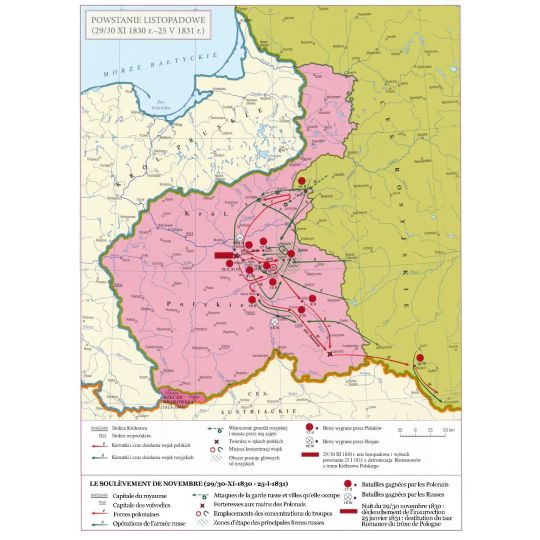
The Polish revolts of the 19th century
🇵🇱 "Wielki atlas historyczny", éd. Demart, Varsovie, 2023
by cartesdhistoire
In 1815, the Congress of Vienna gave Russia the majority of Polish territories called the "Kingdom of the Congress". Krakow, which benefits from the Austro-Russian rivalry, is independent.
In 1830, when the Tsar decides to send Polish troops to fight the revolutionary troubles in France and Belgium, an uprising broke out in Warsaw, and then wins the entire kingdom. The "November uprising" quickly turns into open war, which the insurgents finally lose, who lack foreign support and that of small peasantry.
Then, Patriotic Actions (June 11 & Nov 29) 1860) murderous repressions (February 27th. and April 8, 1861). In October 1862, the head of the civil government announces an uprising of recruits, which primarily affects patriotic activists. This raft marks the beginning of an uprising, generalized but disorganized; evolving into a guerrilla, it is crushed by the Russian army (January). 1863 - June 1864).
The kingdom already lost in 1841, its currency, the złoty, to the benefit of the ruble, then, in 1847, the Napoleon code to the benefit of Russian law and, in 1849, its system of weight and measurements ceased to exist. It is directly incorporated into the Russian empire as the "Vistula Country", a purely geographical name that emphasizes the will to deny its Polish character. Many insurgents are deported to Siberia and their lands confiscated. Russian becomes the official language, all universities are russified, Orthodox Christianity is promoted state religion. The Catholic Church sees its property confiscated, its monasteries closed, its bishops jailed or deported (there hasn't been a single in 1872) and a huge Orthodox Cathedral is built in the heart of Warsaw. A drastic police regime makes any form of cultural activism or armed uprising impossible.
In the Prussia Grand Duchy of Poznan, an uprising took place in the spring of 1848. After his failure, the autonomy, already limited, of the Grand Duchy is abolished.
54 notes
·
View notes
Text
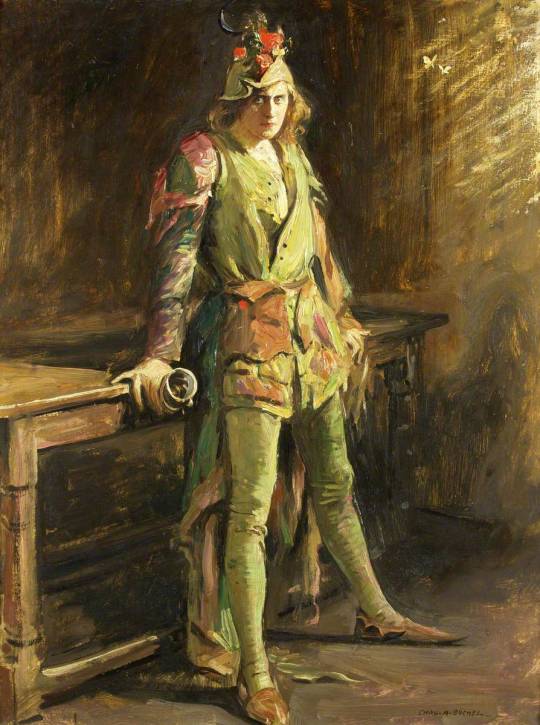
Herbert Beerbohm Tree as Gringoire in 'The Ballad Monger', c.1912
Charles A. Buchel (1872–1950)
University of Bristol Theatre Collection
#pierre gringoire#the ballad monger#herbert beerbohm tree#haven't read the play yet#it's not based on Notre Dame#charles a. buchel#art#theatre#1910s#fin de siècle#what a name#university of bristol theatre collection
29 notes
·
View notes
Text
Welcome to my insane rant about Van Helsing, in the Dracula Hammer movies (with art)

*Quick* explaination of @quijicroix 's and I headcanons for Helsing, and why we think Lawrence (thought it was Abraham but no it's Lawrence in the Hammer cinematic universe) and Lorrimer Van Helsing are the same person (/!\ spoilers for the Hammer's Dracula movies obviously) :
At the end of Brides of Dracula (the second film in the timeline), we see Lawrence get bitten by a Vampire, not Dracula btw, and to remedy the curse he burns his neck and pour holy water on it. And ig by the power of jesus he doesn't get turned into a vampire (boring Hammer resolution) (and he doesn't even get a cool scar).
But we call bullshit on this ! Van Helsing definetly got turned into a (half) vampire !!
1) Lawrence and Lorrimer are both played by Peter Cushing and have the same face. Now I know what your probably thinking "this argument is lazy af", and if we stopped there, yes it would be. But we see Lawrence's son in 7 Golden Vampires (the last film in the serie, but not the timeline) !! And he looks NOTHING like Peter Cushing. So either the Cushing face skipped a generation (whitch is funny to imagine), or his son, who stays in china and never returns to england, serves as a way to help him hide his immortality by taking the identity of his own son, then his grandson Lorrimer.
2) Time for maths everyone ! In Dracula AD 1972, we learn Lawrence died in 1872. BUT !! In 7 Golden Vampires that takes place in 1904 (because the begining of the film is set in 1804 and these movies are obsessed with the 100 years later trope), who is still perfectly healthy and visiting his son in China more than twenty years after his death ?? Lawrence fucking Van Helsing. The only two explainations I see are either Vampirism or tax fraud.
And that would mean his son (Leyland Van Helsing btw) had to fuck very quickly after the movie for Lorrimer to be in his 70s (?) in 1972.
3) If curing vampirism was this easy, why kill the other people who got turned into vampires later in the timeline (rip a lot of the women and Johnny Alucard) ?? It paints Van Helsing in a way better light if you assume his miraculous cure didn't work *in the second film of this 9 movie saga*, and he doesn't just kill people he could cure.
4) it would be a very interesting take on the character, the renown vampire hunter himself becoming a monster, fighting to keep his humanity (but the Hammer didn't have the balls. And we thought about these movies way more than anyone involved in writting them-).
And the circle of violence theme is not between Dracula and the Helsing family anymore, but between him and Lawrence, whitch is way more personnal. And !! raises the stakes in both Dracula AD 1972 (already the best movie out of the 9 by far btw) and Satanic Rites since Dracula isn't the vampire his grandad fought, but his century long ennemy that keeps coming back.
And the scene at the end of Satanic Rites, where Dracula (for the first time in 9 movies) manage to align two sentences and basicly say he wants to end the world because he is tired of dying and coming back !!!!! Whitch is very heartbreaking already, but if he says it to the man who killed him (nearly) everytime ??? (We don't talk about that time Quatermass got him) Aaaaaaaaaaaaaaaaaahhhhhhhhhhhhhh
Ok I lied this was not quick but this!!!!!! Is something that has been haunting us for months, and in the words of Quiji : "People need to know."

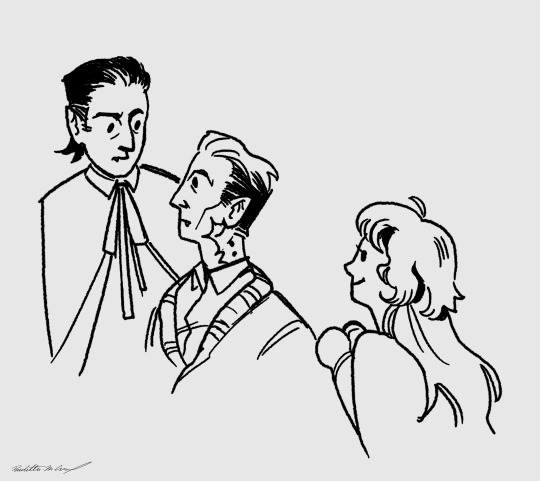
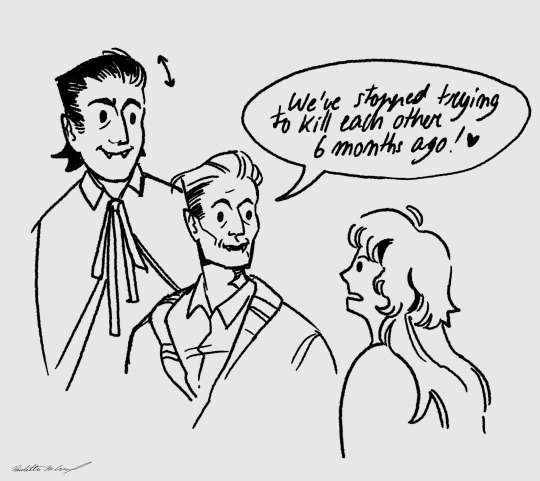
I'm also working on an illustration in whitch this headcanon of ours is pretty central <3
#I've watched way to much hammer movies why-#btw the best line I've ever read in a fanfic comes from this fandom : “Are you a feminist Mr Van Helsing ?”#this has entered my everyday vocabulary#lorrimer van helsing#lawrence van helsing#jessica van helsing#dracula#hammer dracula#the brides of dracula#dracula ad 1972#the satanic rites of dracula#7 golden vampires#horror of dracula#hammer movies#vampires#van helsing#sketches#art#my art#fanart#dracula fanart#long post#peter cushing#christopher lee
74 notes
·
View notes
Text
ANON FJSAOFJDKFJLAKJFDAF
i don't even dislike bucky as a character i'm just! so very uninterested in the romantic dynamic ppl paint between him & steve it truly inspires nothing within me.
(and! if you're looking to scratch that friends-to-lovers itch 616!stevetony is right! there! or if you're looking to scratch the friends-to-unwilling enemies-to-tentative allies-to-friends-to-lovers itch, again!!! 616!stevetony is serving it at the all-you-can-eat ship dynamic buffet!)
the thing that really soured me on the ship was the fans and i hate to say that bc everyone should get to enjoy what they enjoy! but yeah there's nothing groundbreaking or progressive about a story with two men sharing a meaningful friendship that can be read as having homoerotic subtext.
#obligatory not all fans!! but yeah it can be a bit grating lol#for your safety and mine i will not be posting your asks but i am happy to let you vent in my askbox for a bit <3#i find myself way more drawn to 616!bucky and steve's relationship because can you imagine how fucked up it would be to see#the kid that used to look up to you and fight beside you and whom you took under your wing and tried to protect and FAILED to protect#during the war coming back into your life as a hardened haunted man. how do you forgive yourself for letting him down like that??#how can he ever bring himself to forgive you?? even though you both know that you aren't responsible for all the hurt#you're also the only one willing to bear the burden of apology for any of it#also buckynat in any universe slaps they go hard in mcu 616 1872 ETC (except ults but bucky's got his own thing going on there)#james barnes#anon#signed sealed delivered
18 notes
·
View notes
Text
the relationship between vampirism & queerness
Vampires are inherently queer characters. Their queerness is represented in countless texts including Bram Stoker’s novel, Dracula (1897), Sheridan Le Fanu’s novella, Carmilla (1872), the film Interview with the Vampire (1994), and Rainbow Rowell’s novel Carry On (2015). Vampires’ queerness is enforced by a multitude of factors; notably the sexual nature of a vampire itself, the relationship vampires have with ‘normal’ society, and the inherent evilness behind vampires.
The queerness of vampires is enforced by the sexuality behind the concept of a vampire itself. Unlike other monsters, vampires are not apparently beastly or undead. Their evil nature is hidden beneath a suave, charismatic personality. The ‘charming vampire’ character was first popularised by John William Polidori in his 1819 short story, The Vampyre. This story was a source of inspiration for Carmilla and Dracula, who further cemented ‘charisma’ into the fundamentals of the vampire archetype. A part of vampires’ hunting method is seduction, which often leads to a blurry line between ‘prey’ and ‘romantic interest’. One of the most iconic traits of a vampire is the bite to the neck. Popularised by Bram Stoker, vampires typically drain their victims of blood from the neck. While it’s a convenient spot because of the carotid artery, a plentiful source of blood, it’s often argued that the sexual nature of biting one’s neck played a large part in the popularisation of it.
The sexulisation of vampires opens up an opportunity for authors to explore queerness in a non-explicit setting. The relationship between a vampire and their victim can mirror that of a romantic/sexual couple. Often vampire characters are more fluid with their sexuality and they influence their human prey with their vampiric, sexual, queer nature. In Interview with the Vampire, Louis de Pointe du Lac’s story starts with his partner, Lestat de Lioncourt turning him into a vampire. The scene in which Lestat bites him includes him pinning Louis to the ground and biting his neck before whispering in his ear. “You can be young always, my friend, as we are now.” Lestat’s use of ‘we’ as opposed to ‘you can stay young’ shows his interest in staying with Louis. Louis’ character development stems from a queer male vampire changing his life. Count Dracula’s prisoner was Jonathon Harker, with whom he was extremely infatuated. Upon finding other female vampires attempting to bite Jonathon’s neck, Dracula was outraged. "How dare you touch him, any of you? How dare you cast eyes on him when I had forbidden it? Back, I tell you all! This man belongs to me!” Dracula was possessive of Jonathon, which alludes to an attraction beyond chaste fascination. In Carmilla, the titular character came into human Laura’s life and engaged her in a romantic relationship. Carmilla says “‘I have been in love with no one, and never shall,’ she whispered, ‘unless it should be with you.’” to Laura, who consistently described Carmilla as attractive, “She was so beautiful and so indescribably engaging.” While it’s up to the reader if Carmilla’s feelings were simply an act used to lure Laura in or true love, their relationship was intimate and unmistakingly queer. In Carry On, Tyrannus Basilton ‘Baz’ Grimm Pitch never bites Simon Snow, but they are involved. Baz says “You were the centre of my universe. Everything else spun around you.” While Baz did not attempt to make Simon a vampire, he was knowingly queer before Simon; Simon was unaware of his own queerness before Baz. This is another example of a queer vampire influencing their human partners. The queer themes in these texts are fueled by the sensual nature of the vampire characters.
One way vampires are shown as an allegory for being queer, is the relationship vampires have with regular society. A vampire fitting in with human communities is difficult, due to the inability to be in sunlight or eat normal food. Queer folk historically struggle to fit into heteronormative spaces seeing as, like vampirism, it’s been widely viewed as a negative trait. That sense of displacement or otherness felt by queer people is mirrored by vampires. Count Dracula’s odd behaviour was quickly picked up on by Jonathon. Upon finding Jonathon using a shaving mirror, Dracula was enraged. “This is the wretched thing that has done the mischief. It is a foul bauble of man's vanity. Away with it!" And opening the window with one wrench of his terrible hand, he flung out the glass.” Similarly, Simon always suspected Baz was a vampire, and spent his highschool career trying to prove it. “Are you saying you don’t think Baz is a vampire?” “I know he’s a vampire. But it’s still unconfirmed.” Baz being odd because he was a vampire is not unlike his being different because he was queer. Baz was always self aware he was unlike everyone else. Baz and Simon in a crowded room: “They’ll know that we’re gay.” “There go my job prospects. What will my family say? Baz, you’re actually, literally the only thing I have to lose. So as long as doing gay stuff in public doesn’t make you hate me, I don’t really care.” Regular, heteronormative, human society makes both the vampire community and queer people feel like outsiders; creating a sense of guilt for being different. Baz and Louis have both chosen to drink rat blood to avoid drinking humans. Their inner turmoil over being a blood-sucking demon reflects the common queer mindset of feeling guilty over being different. The sense of ‘otherness’ unites queer folk and vampires.
From their conception in common folklore, vampires have been written as evil, soulless beings. Vampires are undead demons that drink blood and transform innocent humans into more blood-drinking demons. The queerness behind vampire characters is linked to their being inherently evil. Vampires turning humans into vampires is a metaphor for gay people ‘corrupting’ others with their homosexuality. After the death of his wife and child, Louis was attacked by Lestat and turned into a vampire. Lestat gave him a whole new life and they adopted a daughter, Claudia. Louis went from a ‘straight’ human man who played his part in regular society, to a queer vampire. Vampires have a massive influence over their victims and partners. Their influence, in terms of both vampirism and homosexuality, leaves lasting effects on their prey. In the aftermath of Carmilla and Dracula, Laura and Jonathon are said to have struggled with recovery. From Carmilla, “The following Spring my father took me a tour through Italy. We remained away for more than a year. It was long before the terror of recent events subsided.” Vampires’ impact on their human partners is not necessarily for the better. For Laura, it was detrimental to herself, whereas in other stories, such as Carry On, Simon Snow was better off with his vampire boyfriend. Baz helped him find a version of himself he was unfamiliar with and they started their new life together. “He's not a villain. He's just a boy. I'm kissing a boy. I'm kissing Baz.”
Vampirism is an allegory for being queer. The queerness with which vampire characters are written is shown through the sexulisation of vampires, the sense of ‘otherness’ felt by both parties, and the inherent evil nature behind vampires. The evidence and recurring themes across Dracula, Carmilla, Interview with the Vampire and Carry On show the ways in which queerness shows itself in vampire texts. Writers using vampires as an outlet for queer allegories implies an urge on the author’s part to explore a more fluid perspective on sexuality. I think a lot of the appeal of vampire texts and characters lies in the desire to fantasise about a different way of being — it’s a safe, abstract way of exploring one’s own sexuality through stories. Vampires represent homosexuality in a subtle, indirect way that connects with the queer community and create a way to show queer stories without being blatantly queer.
#essay#writing#vampires#queerness#dracula#bram stoker#interview with the vampire#anne rice#carry on#rainbow rowell#carmilla#sheridan le fanu#vampire#dracula daily#you might be interested#queer#gay#1313 words#which is cool#jonathon harker#count dracula#simon snow#baz grimm pitch#tyrannus basilton grimm pitch#carry on series#louis de pointe du lac#lestat de lioncourt#iwtv#carmilla x laura#snowbaz
406 notes
·
View notes
Note
Your post about the Victorians’ attitudes towards the Regency is so interesting!! Do we have any examples of them satirizing or otherwise lambasting the attire of other eras? My teacher once said they hated the Georgians but I’ve also read that was a big 1870s influence so unsure if that’s right.
I think this is where it helps to remember that the Victorian EraTM was a 60-year span of time, and the Georgian era similarly expansive. Parts of it were in and out of favor during parts of the former, so it's not quite correct to say "the Victorians hated the Georgians."
(Also, for fellow non-Brits who were confused by the Georgian/Regency distinction like I first was: the Regency was part of the Georgian era. So were most of the 1820s and 1830s. Georgian does not just refer to the panniers/powdered wigs period. The more you know!)
There was a massive late 17th/early-mid 18th-century influence on fashion in the 1870s and 80s, yes! It's why I get annoyed when people claim that bustles are based on the- very real -exploitation and fetishization of Sarah Baartman (c. 1789-1815). They became popular nearly 60 years after her death, and took inspiration from clothing that went out of style decades before she was born.

(La Comtesse de Mailly, 1698)
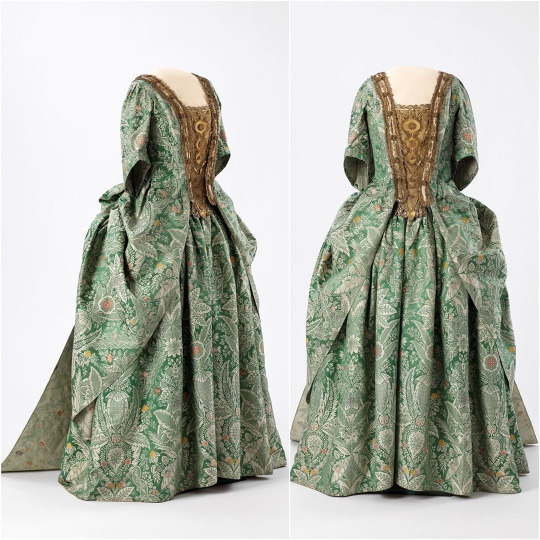
(1720s dress, National Museum, Norway.)
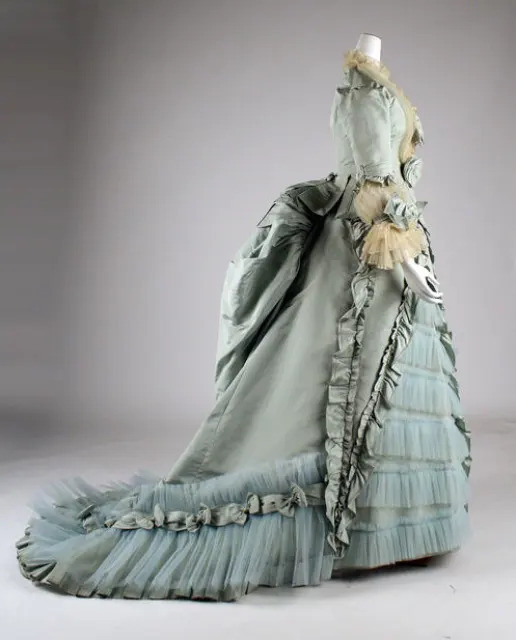
(Gown from the Met Museum's collection, c. 1872. Note the ruffled 3/4 sleeves, skirt back fullness, and appearance of an underskirt/overskirt arrangement. Low-ish, square necklines were also popular at the time, though not universal.)
As for satirizing other eras of fashion, I'm sure it happened in abundance; what interests me more, however, is the spreading of outright misinformation about how their ancestors dressed. One of the best-known examples is their take on the "iron corset" of the Medieval and Renaissance periods:

(Illustration from The Corset and the Crinoline, published 1868. One 1871 writer from the London Times dismissed the notion that such garments were orthopedic devices as "superficial falsehood," despite the fact that we now know- and clearly at least some people did back then, too! -that primary sources identify them exactly that way.)
While real examples of iron support garments do exist- as do extant accounts identifying them as medical aids -a roaring reproduction trade sprung up during the Victorian era. At least partially for fetish reasons, it is now believed, echoing the anonymous tightlacing erotica found in such publications as the misleadingly-named Englishwoman's Domestic Magazine.
And that's just one example. The more things change, the more we remain convinced that our ancestors were complete idiots who had no idea how to dress themselves sensibly.
#ask#anon#marzi rambles#long post#dress history#victorian#georgian#history misconceptions#fashion history
82 notes
·
View notes
Text

SIGN UPS OPEN FOR TONY'S BIRTHDAY GALA EXCHANGE IN 24 HOURS ON MONDAY, FEBRUARY 20TH AT 12PM NOON EST.
Sign ups will remain open until March 10th at noon EST.
Please be sure to reread the RULES, FAQ, and SCHEDULE. If you've never participated in an exchange event run on AO3 before, you can also look at HOW TO SIGN UP.
Parties are hard to plan, and we need to be meticulous in planning Tony's big bash. So...be thinking of what you'd like to request a writer or artist make for you, and what you would be willing to make for someone else.
Please don't hesitate to reach out here or on Twitter if you have any questions.
AO3 SIGN UP LINK | PINCH HITTER FORM
(Both of the above links will become active at noon EST tomorrow.)
#tony stark#iron man#marvel#marvel cinematic universe#mcu#marvel comics#marvel 616#marvel ultimates#marvel noir#marvel 1872#avengers assemble#avengers#stony#stuckony#winteriron#ironshield#ironfrost#ironstrange#pepperony
41 notes
·
View notes